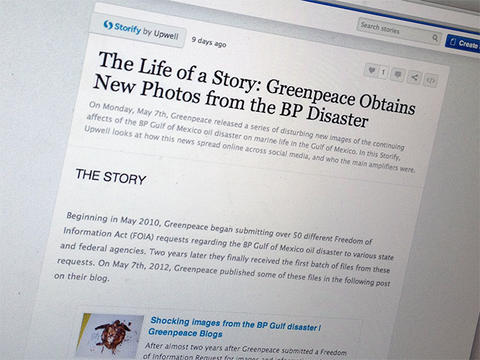Blog Feed
Oil Spill Turtle Photos + Ocean Plastic and Sea Skater Eggs + Pancakes: Sea Signals for Week of May 7, 2012
Oil Spill Turtle Photos
The story about Greenpeace releasing photos of oil-covered turtles from the BP Disaster, appeared first in the Washington Post on May 6th, but gained real social traction with a May 7th Mother Jones story. Boing Boing, and the Huffington Post coverage, along with additional stories and tweets, kept the story alive.
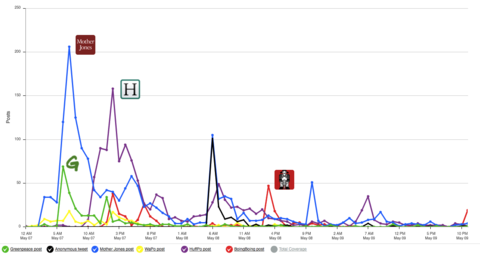
Number of online mentions (including blogs, social media, and forums) between May 7th and May 9th, 2012.
Amplification Action
At Upwell, we reached out to organizations and bloggers that have a vested interest in turtles and oil spill restoration, and who had recently posted about Gulf oil spill restoration efforts. Healthygulf.org posted about the story, and shared it with its network.
We also used Storify to document how the story spread across social media and to see who the key infuencers were on blogs and Twitter. As of this writing, the Storify had received 260 views on Storified and a handful of retweets.
Learnings
• Bloggers in smaller outlets were relatively easy to reach and interested in the big story
• Storify is an effective tool for sharing the life of a story, but it’s challenging to measure its impact, aside from views on the actual Storify.
• Bitly links cannot be used to share links to stories on Storify, but they can be embedded into the text between story blocks.
• If you use the automated tweeting function to notify Twitter users that they have been mentioned in the story, a Storify URL will be generated that you can’t track. To measure impact, it’s better to tweet folks manually, and to use your own bitly link.
Ocean Plastic and Sea Skater Eggs
On May 8th, at 4:01 PM PT, Scripps Oceanography News released news of a Scripps study by Miriam Goldstein about how plastic trash is altering the ocean habitat of a marine insect, the Sea Skater (Halobates sericeus). By the following morning, May 9, the story was covered by major news outlets and was shared by many ocean-focused organizations.
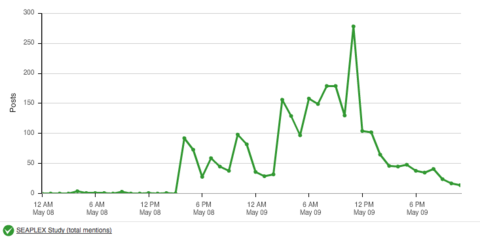
Number of online mentions (including blogs, social media, and forums) of the SEAPLEX study between May 8th and May 9th, 2012.
Amplification Action
At Upwell, our goal was to let ocean conservation organizations, particularly ones that focused on plastic pollution, know about the story through and Twitter and Facebook.
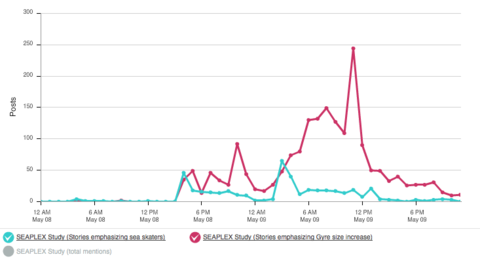
Sea skaters vs. Gyre size emphasis in number of online mentions (including blogs, social media, and forums) of the SEAPLEX study between May 8th and May 9th, 2012.
Learnings
• We'll be talking with Miriam Goldstein about how she did outreach, and will share our learnings with you in a future post.
• Some of the news outlets changed the headline from being about the insects to being about the “100-fold upsurge in human-produced plastic garbage.” This dramatically increased the story’s traction.
Pancakes - A Sustainable Seafood
Photos of these amazing pancakes by blogger Nathan Shields made the rounds on Twitter in early May and we, being sustainable seafood advocates, fell in love with marine invertebrates. In the spirit of fun for a Friday we wanted share the photos as another type of sustainable “seafood.” Oceana and Oceanwire shared the image on May 9.
Amplification Action
We reached out to sustainable seafood organizations and activists via Twitter, Facebook and email and encouraged them to blog about the photos or share with their audiences via Twitter.
Learnings
• When trying to share photo links for this in Facebook they did not automatically appear as usual when putting a link in the “comment” box. We had to upload separately.
• As of the writing of this post no additional traction to report.
Other ocean-related stories that caught our eye this week:
• “Marine Ecosystem Pledges Unmet, Data Shows” by David Jolly for The New York Times
• June is National Oceans Month. June 8th is World Oceans Day
• David Shiffman’s Twitter discussion and Storify about Shark Fin Bans
• Dolphins Die of Drug Overdose at Swiss Raid by Tim Newcomb for TIME
• If You Collected All of the Earth’s Water Into a Sphere, How Big Would It Be? by Robert T. Gonzalez for i09
• The trailer for Midway a documentary about the effect of the Pacific Garbage Patch on birds.
What stories shall we amplify this week? Let us know! Email tips@upwell.us, or tweet us @upwell_us.
Storify: Greenpeace FOIA release of photos BP Disaster
A story about Greenpeace releasing photos of oil-covered turtles from the BP Disaster, appeared first in the Washington Post on May 6th, but gained real social traction with a May 7th Mother Jones story. Boing Boing, and the Huffington Post coverage, along with additional stories and tweets, kept the story alive.
We also used Storify to document how the story spread across social media and to see who the key infuencers were on blogs and Twitter. As of this writing, the Storify had received 265 views on Storified and a handful of retweets.
Are Humans and Reef Sharks Mutually Exclusive?
Over at Deep Sea News, a blog post last Monday asks whether humans and reef sharks are mutually exclusive. The post summarizes a new paper in Conservation Biology, which “studied populations of reef sharks in the Pacific and attempted to reconstruct what the “starting” populations would have been before human activities began to affect them and before anyone thought to monitor reef shark populations.” The graph below demonstrates “the relationship between the density of sharks … and the number of humans living within 200km of the sampling site” and shows (with the exception of one outlier, highlighted by DSN), that “the relationship is heavily, heavily skewed.”
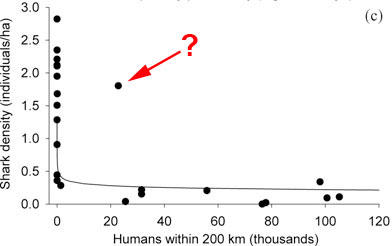
Photo Caption: This is a graph with a mysterious outlier
Notes DSN: “If this proves true then it may not be that humans are doing anything to the sharks per se, just not looking after the reef generally, and that is being reflected at the top trophic level. However you slice it, their results are more grist to the mill that we need to be doing a better job with the conservation of both reefs and sharks, because sometimes those two things are inextricably intertwined.”
Keep an Eye On: Battle over the Arctic
Legal battles are brewing in the Arctic over Shell’s plans to conduct exploratory oil drilling in the Beaufort Sea, beginning next month, and environmental groups’ desire to stop them.
On Monday, Shell sued 13 environmental groups, “seeking a Federal Court order declaring it legally authorized to proceed with Arctic Ocean drilling this summer, despite the groups' complaints.” The move comes after Greenpeace activists confronted the Nordica, an icebreaker that is en route to the western Arctic to function as a support vessel for Shell’s drilling fleet, four times in four days in the North Atlantic:
20 Greenpeace Nordic activists boarded the Nordica in Helsinki, Finland. When the first team of activists was arrested, 22 more activists arrived onsite in two inflatable boats and three canoes. Two days later, six Greenpeace Nordic activists boarded the same vessel off the coast of Sweden and until Swedish authorities were called to the scene. Two days later, six Greenpeace Nordic activists boarded the same vessel off the coast of Sweden until Swedish authorities were called to the scene. After 10 hours the activists were removed by a SWAT team and taken into custody. They were arrested under preliminary charges of aggravated trespass and arbitrary conduct.
Previous Greenpeace actions against other vessels in the fleet before their departure for the Arctic prompted Shell to seek – and receive – a protective order preventing Greenpeace from interfering with those vessels once they are on site. The new legal measure does not, however, address direct actions, but seeks to “prevent 12 other environmental groups from launching ‘last-minute legal challenges’ to its drilling.”
Why This Matters: The Arctic is emerging as the newest, and arguably most significant, environmental front line, especially as it relates to marine issues. With new information emerging about the possible impact of the Deepwater Horizon oil spill on the likes of turtles, seafood and human health, environmental groups are keen to emphasize the likely severity of a similar accident in an Arctic environment, and to highlight the readiness of the oil industry to expand its operations in this environment even in the aftermath of the Gulf of Mexico incident. In addition, of course, the Arctic, and particularly Arctic sea ice, is being impacted significantly by climate change – the result of the burning of fill fuels such as the oil that Shell seeks to extract from the Beaufort.
